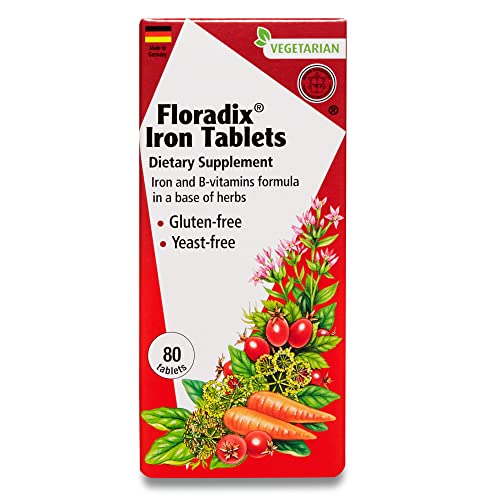
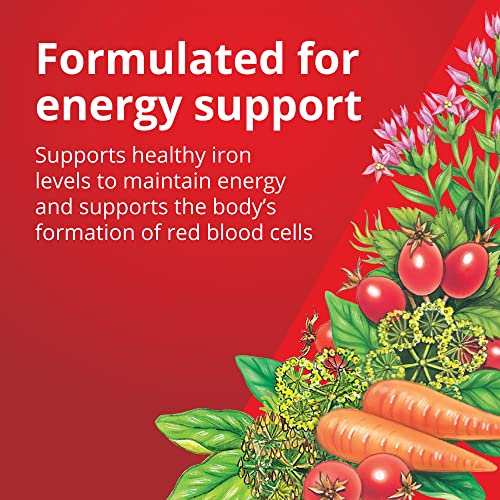
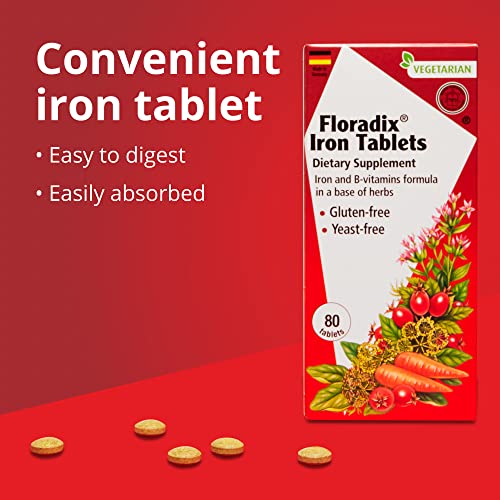
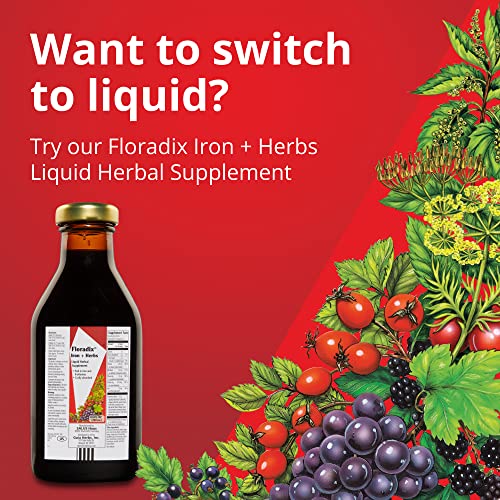

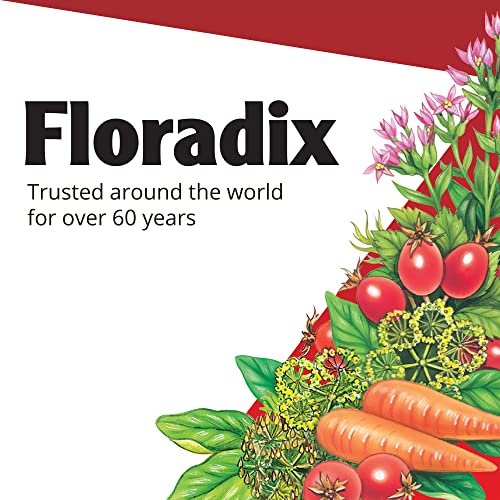
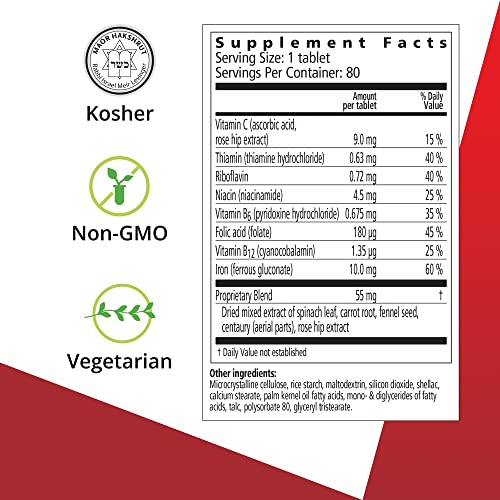
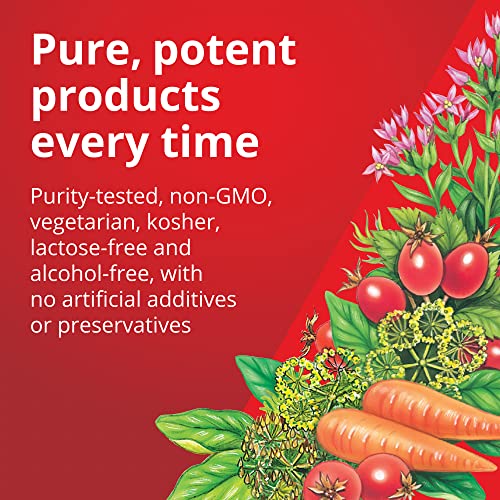
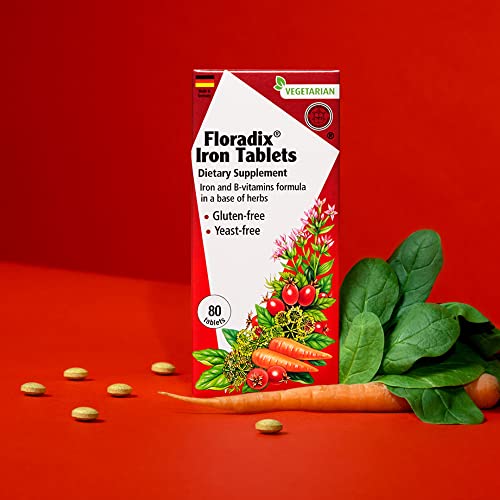
Floradix Iron Supplements - Natural Energy Support, Herbal Formula, Vegetarian - 80 Count


Talc
High RiskTalc is a powdered native, hydrous magnesium silicate mineral commonly used in cosmetics and personal care products for its absorbent properties and ability to improve texture. It serves as a filler, anti-caking agent, and lubricant in formulations.
Sustai Insights
Talc offers functional benefits, including moisture absorption and smooth application in products. However, it poses health risks, particularly regarding potential carcinogenicity concerns and regulatory restrictions in cosmetics. Environmental impacts include pollutant potential and risk of bioaccumulation. Regulatory agencies have issued warnings about its use in certain applications. Overall, talc is assessed as high risk due to these factors. Recommended alternatives include cornstarch or rice powder for safer applications.
Peg 6 Sorbitan Oleate
Medium RiskPEG-6 Sorbitan Oleate is an ethoxylated sorbitan ester derived from sorbitol and oleic acid. It functions primarily as an emulsifier, helping to blend oil and water in various formulations, and is commonly used in personal care and cosmetic products.
Sustai Insights
PEG-6 Sorbitan Oleate offers effective emulsification properties, enhancing product texture and stability. It is generally considered to have low carcinogenicity and developmental toxicity, while moderate concerns exist regarding allergies and immunotoxicity. Contamination risks are notable. This ingredient is subject to regulatory restrictions and should be used cautiously, particularly for sensitive populations. Alternatives include natural emulsifiers such as beeswax or lecithin. The overall risk assessment is moderate.
Vitamin B3
Low RiskVitamin B3, also known as niacin or nicotinic acid, is an organic compound that plays a crucial role in various metabolic processes in the body. It is commonly used in cosmetic formulations for its ability to improve skin texture and enhance moisture retention, thereby contributing to overall skin health.
Sustai Insights
Vitamin B3 offers functional benefits such as improving skin hydration, reducing the appearance of fine lines, and enhancing overall skin tone. It is generally recognized as safe, with low associated health risks, including minimal concerns for carcinogenicity, allergies, or reproductive toxicity. Environmentally, it poses low risks and is not classified as a pollutant or bioaccumulative. Regulatory bodies have not placed substantial restrictions on its use, affirming its safety in cosmetic applications. Overall, Vitamin B3 is considered a low-risk ingredient, with no significant adverse effects reported. Safe usage practices include using within recommended concentrations, and alternatives like Vitamin B5 can be considered for similar benefits.
Iron
Low RiskIron is a mineral that plays a vital role in various biological processes, primarily as a component of hemoglobin in red blood cells, facilitating oxygen transport. It is commonly used in dietary supplements and food fortification to address iron deficiency and support overall health.
Sustai Insights
Iron offers essential functional benefits, such as improving oxygen circulation and supporting metabolic processes. It is generally considered safe with low risks for carcinogenicity, allergenic potential, and reproductive toxicity. Regulatory bodies like the FDA do not impose significant restrictions on its use. However, excessive iron intake can lead to health risks, including toxicity. Environmentally, iron is not known to be a pollutant or bioaccumulative. Overall, iron is assessed as low risk, with safe usage practices advised, including monitoring intake levels. Alternatives for supplementation include dietary sources like spinach and legumes.
Riboflavin
Low RiskRiboflavin, also known as Vitamin B2, is a water-soluble vitamin essential for energy production and cellular function. It plays a critical role in the metabolism of fats, carbohydrates, and proteins, and is commonly used as a dietary supplement and food additive for its color and nutritional benefits.
Sustai Insights
Riboflavin offers functional benefits, including its role in energy metabolism and as a food colorant. It is generally recognized as safe with low risk for allergies, carcinogenicity, and reproductive toxicity. However, excessive intake can lead to minor side effects such as yellow urine. Environmentally, riboflavin poses low pollutant potential and is not bioaccumulative. Regulatory bodies like the FDA have approved its use, establishing a low risk profile overall. Recommended usage levels are safe, and alternatives include other B vitamins, ensuring a balanced intake.
Fatty Acids
Low RiskFatty acids are organic compounds composed of long hydrocarbon chains with a carboxyl group at one end. They serve various functions in cosmetic formulations, including acting as emollients, emulsifiers, and surfactants, contributing to product texture and stability.
Sustai Insights
Fatty acids offer functional benefits such as enhancing skin hydration and improving product consistency. They are generally recognized as safe by regulatory bodies, with low concerns regarding carcinogenicity, allergies, and reproductive toxicity. Environmental risks are minimal, as they are often biodegradable and not bioaccumulative. Regulatory agencies have not issued significant warnings against their use. Overall, fatty acids present a low risk profile, making them a favorable choice in cosmetic applications. Safe usage practices should be followed, and alternatives include plant-based oils for sustainability.
Calcium Stearate
Low RiskCalcium stearate is a calcium salt of stearic acid, primarily used as a lubricant and emulsifying agent in various products. It is commonly found in cosmetics, pharmaceuticals, and food applications, where it serves to enhance texture and stability.
Sustai Insights
Calcium stearate offers functional benefits as an effective emulsifier and stabilizer. It is generally recognized as safe by regulatory bodies, with low concerns regarding carcinogenicity, allergies, and reproductive toxicity. Environmental assessments indicate low pollutant potential and minimal bioaccumulation. Regulatory agencies have not imposed significant restrictions. Overall, the ingredient is considered low risk for health and environmental impacts, with safe usage practices recommended.
Tristearin
Low RiskTristearin is a triester of glycerin and stearic acid, primarily used as an emulsifier and stabilizer in various cosmetic and food products. It helps to blend ingredients and maintain product consistency, enhancing texture and shelf life.
Sustai Insights
Tristearin offers functional benefits as an emulsifier, promoting stability and texture in formulations. It is generally recognized as safe, with low concerns for carcinogenicity, allergies, and reproductive toxicity. Environmental risks are minimal, with no significant pollutant potential. Regulatory bodies have not issued warnings or restrictions, indicating a low-risk profile overall. Safe usage practices should be followed, and alternatives include natural emulsifiers like lecithin.
Ascorbic Acid (Vitamin C)
Low RiskAscorbic acid (Vitamin C) is a naturally occurring antioxidant essential for various biological functions, including collagen synthesis and immune response. It is commonly used in cosmetic and food products for its preservative properties and ability to enhance skin brightness.
Sustai Insights
Ascorbic acid provides functional benefits as an effective antioxidant and preservative, contributing to skin health and product stability. It is generally recognized as safe with low health risks, including minimal concerns for carcinogenicity and allergies. Environmentally, it poses low risks, as it is biodegradable and does not bioaccumulate. Regulatory bodies like the FDA have not imposed significant restrictions on its use. Overall, the ingredient presents a low risk, with safe usage practices ensuring consumer safety, and alternatives such as natural extracts exist for those seeking different formulations.
Rose Hip Extract
Low RiskRose hip extract is derived from the fruit of the Rosa canina plant and is commonly used in cosmetic and skincare formulations for its potential antioxidant properties. It may support skin health through hydration and soothing effects, functioning primarily as an emollient and skin conditioning agent.
Sustai Insights
Rose hip extract offers functional benefits such as skin hydration and antioxidant properties, contributing to improved skin appearance. It is considered low risk regarding health concerns, with minimal allergenic potential and no significant regulatory restrictions. Environmental risks are also low, and it is not known to bioaccumulate. Overall, the ingredient is assessed as low risk, making it a viable option in formulations with safe usage practices.
Maltodextrin
Low RiskMaltodextrin is a saccharide material obtained from starch through partial hydrolysis. It is commonly used as a thickener, filler, or preservative in food and cosmetic products due to its ability to enhance texture and stability.
Sustai Insights
Maltodextrin serves as an effective thickener and stabilizer in various products, and it is typically derived from renewable sources. Health risks are minimal, as it poses low concerns for carcinogenicity, allergies, and developmental toxicity. Environmental impacts are also low, with no significant pollutant or bioaccumulation potential. Regulatory bodies do not impose major restrictions on its use. Overall, maltodextrin presents a low-risk profile, making it a widely accepted ingredient in food and cosmetic formulations.
Cyanocobalamin (Vitamin B12)
Low RiskCyanocobalamin, commonly known as vitamin B12, is a water-soluble vitamin essential for red blood cell formation, neurological function, and DNA synthesis. It is utilized in dietary supplements and fortified foods to prevent or treat B12 deficiency, particularly in individuals with limited dietary intake or absorption issues.
Sustai Insights
Cyanocobalamin serves critical physiological functions including energy metabolism and red blood cell production. It is deemed safe with low health risk concerns across various categories such as cancer, allergies, and reproductive toxicity. Environmental impact is minimal, lacking bioaccumulation or significant pollutants. Regulatory bodies, including the FDA, recognize its safety, affirming low risk overall. Recommended usage involves adherence to established dietary allowances, with few noted alternatives. Therefore, the overall assessment indicates low risk.
Folic Acid
Low RiskFolic acid, also known as vitamin B9, is a water-soluble vitamin essential for DNA synthesis, repair, and methylation. It plays a critical role in cell division and is particularly important during periods of rapid growth, such as pregnancy and fetal development. It is commonly included in dietary supplements and fortified foods.
Sustai Insights
Folic acid offers functional benefits as a vital nutrient for cellular processes and is generally recognized as safe with low associated health risks, including carcinogenicity, allergenic potential, and reproductive toxicity. It is not restricted by regulatory bodies, and sustainable sourcing practices are often employed. Environmental risks are minimal, with no significant pollutant or bioaccumulation concerns. While the ingredient can be beneficial for pregnant women, safe usage practices should be observed to avoid excessive intake. Overall, the risk level associated with folic acid is low, with no major adverse effects reported.
Shellac Cera
Low RiskShellac, also known as cera, is a natural resin secreted by the lac bug, used primarily as a food glaze and in cosmetic formulations. It acts as a film-forming agent, providing a protective coating and enhancing the appearance of products.
Sustai Insights
Shellac is valued for its functional benefits, including serving as an effective film-former and providing a glossy finish in various products. It is derived from natural sources, making it a biodegradable option. Health risks associated with shellac are low, with no significant evidence linking it to carcinogenicity, allergies, or reproductive toxicity. Environmental concerns are minimal, as it does not contribute to pollution or bioaccumulation. Regulatory bodies, including the FDA, have not imposed restrictions on its use. Overall, shellac poses a low risk, making it a safe choice in formulations.
Daucus Carota Sativa (Carrot) Root
Low RiskDaucus carota sativa (carrot) root is a plant-derived ingredient commonly used in cosmetics and personal care products for its moisturizing and antioxidant properties. It is recognized for its potential benefits in skin health due to its nutrient-rich profile, including vitamins and minerals.
Sustai Insights
Daucus carota sativa exhibits functional benefits such as moisturization and antioxidant effects, which can enhance skin texture. It is biodegradable and often sustainably sourced. Health risks are considered low, with minimal concerns regarding carcinogenicity, allergy, or toxicity, as noted by the FDA. Environmental risks are also low, with no significant pollutant or bioaccumulation potential. Regulatory bodies have not issued restrictions, reinforcing its safe use. Overall, this ingredient is assessed as low risk, making it a favorable option in formulations.
Pyridoxine
Low RiskPyridoxine is a substituted aromatic compound, primarily known as vitamin B6. It plays a crucial role in various metabolic processes, including amino acid metabolism, neurotransmitter synthesis, and the production of hemoglobin.
Sustai Insights
Pyridoxine serves essential functions in metabolic processes and is vital for overall health. It poses low health risks, with minimal concerns related to carcinogenicity, allergies, or reproductive toxicity. Environmentally, it is not considered a pollutant or bioaccumulative. Regulatory bodies have not imposed significant restrictions, indicating a low risk overall. Safe usage practices are encouraged, and alternatives like other B vitamins can be considered.
Cellulose
Low RiskCellulose is a natural polysaccharide derived from plant cell walls, primarily used as a thickening agent, stabilizer, and emulsifier in cosmetic formulations. It is known for its ability to improve texture and consistency in products.
Sustai Insights
Cellulose serves as an effective thickening and stabilizing agent, enhancing product texture while being biodegradable and derived from renewable sources. Health risks are minimal, with low concerns regarding carcinogenicity, allergies, and reproductive toxicity. Environmental impacts are also low, as cellulose does not contribute significantly to pollution or bioaccumulation. Regulatory agencies have not issued restrictions on its use. Overall, cellulose presents a low risk profile, making it a suitable ingredient choice in cosmetics.
Elaeis Guineensis (Palm) Kernel Oil
Low RiskElaeis guineensis (palm) kernel oil is an oil derived from the seeds of the African oil palm tree. It functions primarily as an emollient and moisturizing agent in cosmetic formulations, enhancing texture and providing moisture retention.
Sustai Insights
Elaeis guineensis (palm) kernel oil offers functional benefits as a moisturizing agent and is often sustainably sourced. Health risks are low, with minimal concerns regarding carcinogenicity, allergies, or reproductive toxicity. Environmental risks appear low, with no significant pollutant or bioaccumulation issues reported. Regulatory bodies impose few restrictions, suggesting overall low risk. Safe usage practices recommend using it within established concentrations, while alternatives such as coconut oil may be considered for similar functions. Overall, this ingredient presents a low risk profile.
Peg 6 Sorbitan Oleate
Medium RiskPEG-6 Sorbitan Oleate is an ethoxylated sorbitan ester derived from sorbitol and oleic acid. It functions primarily as an emulsifier, helping to blend oil and water in various formulations, and is commonly used in personal care and cosmetic products.
Sustai Insights
PEG-6 Sorbitan Oleate offers effective emulsification properties, enhancing product texture and stability. It is generally considered to have low carcinogenicity and developmental toxicity, while moderate concerns exist regarding allergies and immunotoxicity. Contamination risks are notable. This ingredient is subject to regulatory restrictions and should be used cautiously, particularly for sensitive populations. Alternatives include natural emulsifiers such as beeswax or lecithin. The overall risk assessment is moderate.
Vitamin B3
Low RiskVitamin B3, also known as niacin or nicotinic acid, is an organic compound that plays a crucial role in various metabolic processes in the body. It is commonly used in cosmetic formulations for its ability to improve skin texture and enhance moisture retention, thereby contributing to overall skin health.
Sustai Insights
Vitamin B3 offers functional benefits such as improving skin hydration, reducing the appearance of fine lines, and enhancing overall skin tone. It is generally recognized as safe, with low associated health risks, including minimal concerns for carcinogenicity, allergies, or reproductive toxicity. Environmentally, it poses low risks and is not classified as a pollutant or bioaccumulative. Regulatory bodies have not placed substantial restrictions on its use, affirming its safety in cosmetic applications. Overall, Vitamin B3 is considered a low-risk ingredient, with no significant adverse effects reported. Safe usage practices include using within recommended concentrations, and alternatives like Vitamin B5 can be considered for similar benefits.
Iron
Low RiskIron is a mineral that plays a vital role in various biological processes, primarily as a component of hemoglobin in red blood cells, facilitating oxygen transport. It is commonly used in dietary supplements and food fortification to address iron deficiency and support overall health.
Sustai Insights
Iron offers essential functional benefits, such as improving oxygen circulation and supporting metabolic processes. It is generally considered safe with low risks for carcinogenicity, allergenic potential, and reproductive toxicity. Regulatory bodies like the FDA do not impose significant restrictions on its use. However, excessive iron intake can lead to health risks, including toxicity. Environmentally, iron is not known to be a pollutant or bioaccumulative. Overall, iron is assessed as low risk, with safe usage practices advised, including monitoring intake levels. Alternatives for supplementation include dietary sources like spinach and legumes.
Riboflavin
Low RiskRiboflavin, also known as Vitamin B2, is a water-soluble vitamin essential for energy production and cellular function. It plays a critical role in the metabolism of fats, carbohydrates, and proteins, and is commonly used as a dietary supplement and food additive for its color and nutritional benefits.
Sustai Insights
Riboflavin offers functional benefits, including its role in energy metabolism and as a food colorant. It is generally recognized as safe with low risk for allergies, carcinogenicity, and reproductive toxicity. However, excessive intake can lead to minor side effects such as yellow urine. Environmentally, riboflavin poses low pollutant potential and is not bioaccumulative. Regulatory bodies like the FDA have approved its use, establishing a low risk profile overall. Recommended usage levels are safe, and alternatives include other B vitamins, ensuring a balanced intake.
Fatty Acids
Low RiskFatty acids are organic compounds composed of long hydrocarbon chains with a carboxyl group at one end. They serve various functions in cosmetic formulations, including acting as emollients, emulsifiers, and surfactants, contributing to product texture and stability.
Sustai Insights
Fatty acids offer functional benefits such as enhancing skin hydration and improving product consistency. They are generally recognized as safe by regulatory bodies, with low concerns regarding carcinogenicity, allergies, and reproductive toxicity. Environmental risks are minimal, as they are often biodegradable and not bioaccumulative. Regulatory agencies have not issued significant warnings against their use. Overall, fatty acids present a low risk profile, making them a favorable choice in cosmetic applications. Safe usage practices should be followed, and alternatives include plant-based oils for sustainability.
Calcium Stearate
Low RiskCalcium stearate is a calcium salt of stearic acid, primarily used as a lubricant and emulsifying agent in various products. It is commonly found in cosmetics, pharmaceuticals, and food applications, where it serves to enhance texture and stability.
Sustai Insights
Calcium stearate offers functional benefits as an effective emulsifier and stabilizer. It is generally recognized as safe by regulatory bodies, with low concerns regarding carcinogenicity, allergies, and reproductive toxicity. Environmental assessments indicate low pollutant potential and minimal bioaccumulation. Regulatory agencies have not imposed significant restrictions. Overall, the ingredient is considered low risk for health and environmental impacts, with safe usage practices recommended.
Tristearin
Low RiskTristearin is a triester of glycerin and stearic acid, primarily used as an emulsifier and stabilizer in various cosmetic and food products. It helps to blend ingredients and maintain product consistency, enhancing texture and shelf life.
Sustai Insights
Tristearin offers functional benefits as an emulsifier, promoting stability and texture in formulations. It is generally recognized as safe, with low concerns for carcinogenicity, allergies, and reproductive toxicity. Environmental risks are minimal, with no significant pollutant potential. Regulatory bodies have not issued warnings or restrictions, indicating a low-risk profile overall. Safe usage practices should be followed, and alternatives include natural emulsifiers like lecithin.
Ascorbic Acid (Vitamin C)
Low RiskAscorbic acid (Vitamin C) is a naturally occurring antioxidant essential for various biological functions, including collagen synthesis and immune response. It is commonly used in cosmetic and food products for its preservative properties and ability to enhance skin brightness.
Sustai Insights
Ascorbic acid provides functional benefits as an effective antioxidant and preservative, contributing to skin health and product stability. It is generally recognized as safe with low health risks, including minimal concerns for carcinogenicity and allergies. Environmentally, it poses low risks, as it is biodegradable and does not bioaccumulate. Regulatory bodies like the FDA have not imposed significant restrictions on its use. Overall, the ingredient presents a low risk, with safe usage practices ensuring consumer safety, and alternatives such as natural extracts exist for those seeking different formulations.
Rose Hip Extract
Low RiskRose hip extract is derived from the fruit of the Rosa canina plant and is commonly used in cosmetic and skincare formulations for its potential antioxidant properties. It may support skin health through hydration and soothing effects, functioning primarily as an emollient and skin conditioning agent.
Sustai Insights
Rose hip extract offers functional benefits such as skin hydration and antioxidant properties, contributing to improved skin appearance. It is considered low risk regarding health concerns, with minimal allergenic potential and no significant regulatory restrictions. Environmental risks are also low, and it is not known to bioaccumulate. Overall, the ingredient is assessed as low risk, making it a viable option in formulations with safe usage practices.
Talc
High RiskTalc is a powdered native, hydrous magnesium silicate mineral commonly used in cosmetics and personal care products for its absorbent properties and ability to improve texture. It serves as a filler, anti-caking agent, and lubricant in formulations.
Sustai Insights
Talc offers functional benefits, including moisture absorption and smooth application in products. However, it poses health risks, particularly regarding potential carcinogenicity concerns and regulatory restrictions in cosmetics. Environmental impacts include pollutant potential and risk of bioaccumulation. Regulatory agencies have issued warnings about its use in certain applications. Overall, talc is assessed as high risk due to these factors. Recommended alternatives include cornstarch or rice powder for safer applications.
Maltodextrin
Low RiskMaltodextrin is a saccharide material obtained from starch through partial hydrolysis. It is commonly used as a thickener, filler, or preservative in food and cosmetic products due to its ability to enhance texture and stability.
Sustai Insights
Maltodextrin serves as an effective thickener and stabilizer in various products, and it is typically derived from renewable sources. Health risks are minimal, as it poses low concerns for carcinogenicity, allergies, and developmental toxicity. Environmental impacts are also low, with no significant pollutant or bioaccumulation potential. Regulatory bodies do not impose major restrictions on its use. Overall, maltodextrin presents a low-risk profile, making it a widely accepted ingredient in food and cosmetic formulations.
Cyanocobalamin (Vitamin B12)
Low RiskCyanocobalamin, commonly known as vitamin B12, is a water-soluble vitamin essential for red blood cell formation, neurological function, and DNA synthesis. It is utilized in dietary supplements and fortified foods to prevent or treat B12 deficiency, particularly in individuals with limited dietary intake or absorption issues.
Sustai Insights
Cyanocobalamin serves critical physiological functions including energy metabolism and red blood cell production. It is deemed safe with low health risk concerns across various categories such as cancer, allergies, and reproductive toxicity. Environmental impact is minimal, lacking bioaccumulation or significant pollutants. Regulatory bodies, including the FDA, recognize its safety, affirming low risk overall. Recommended usage involves adherence to established dietary allowances, with few noted alternatives. Therefore, the overall assessment indicates low risk.
Folic Acid
Low RiskFolic acid, also known as vitamin B9, is a water-soluble vitamin essential for DNA synthesis, repair, and methylation. It plays a critical role in cell division and is particularly important during periods of rapid growth, such as pregnancy and fetal development. It is commonly included in dietary supplements and fortified foods.
Sustai Insights
Folic acid offers functional benefits as a vital nutrient for cellular processes and is generally recognized as safe with low associated health risks, including carcinogenicity, allergenic potential, and reproductive toxicity. It is not restricted by regulatory bodies, and sustainable sourcing practices are often employed. Environmental risks are minimal, with no significant pollutant or bioaccumulation concerns. While the ingredient can be beneficial for pregnant women, safe usage practices should be observed to avoid excessive intake. Overall, the risk level associated with folic acid is low, with no major adverse effects reported.
Shellac Cera
Low RiskShellac, also known as cera, is a natural resin secreted by the lac bug, used primarily as a food glaze and in cosmetic formulations. It acts as a film-forming agent, providing a protective coating and enhancing the appearance of products.
Sustai Insights
Shellac is valued for its functional benefits, including serving as an effective film-former and providing a glossy finish in various products. It is derived from natural sources, making it a biodegradable option. Health risks associated with shellac are low, with no significant evidence linking it to carcinogenicity, allergies, or reproductive toxicity. Environmental concerns are minimal, as it does not contribute to pollution or bioaccumulation. Regulatory bodies, including the FDA, have not imposed restrictions on its use. Overall, shellac poses a low risk, making it a safe choice in formulations.
Daucus Carota Sativa (Carrot) Root
Low RiskDaucus carota sativa (carrot) root is a plant-derived ingredient commonly used in cosmetics and personal care products for its moisturizing and antioxidant properties. It is recognized for its potential benefits in skin health due to its nutrient-rich profile, including vitamins and minerals.
Sustai Insights
Daucus carota sativa exhibits functional benefits such as moisturization and antioxidant effects, which can enhance skin texture. It is biodegradable and often sustainably sourced. Health risks are considered low, with minimal concerns regarding carcinogenicity, allergy, or toxicity, as noted by the FDA. Environmental risks are also low, with no significant pollutant or bioaccumulation potential. Regulatory bodies have not issued restrictions, reinforcing its safe use. Overall, this ingredient is assessed as low risk, making it a favorable option in formulations.
Pyridoxine
Low RiskPyridoxine is a substituted aromatic compound, primarily known as vitamin B6. It plays a crucial role in various metabolic processes, including amino acid metabolism, neurotransmitter synthesis, and the production of hemoglobin.
Sustai Insights
Pyridoxine serves essential functions in metabolic processes and is vital for overall health. It poses low health risks, with minimal concerns related to carcinogenicity, allergies, or reproductive toxicity. Environmentally, it is not considered a pollutant or bioaccumulative. Regulatory bodies have not imposed significant restrictions, indicating a low risk overall. Safe usage practices are encouraged, and alternatives like other B vitamins can be considered.
Cellulose
Low RiskCellulose is a natural polysaccharide derived from plant cell walls, primarily used as a thickening agent, stabilizer, and emulsifier in cosmetic formulations. It is known for its ability to improve texture and consistency in products.
Sustai Insights
Cellulose serves as an effective thickening and stabilizing agent, enhancing product texture while being biodegradable and derived from renewable sources. Health risks are minimal, with low concerns regarding carcinogenicity, allergies, and reproductive toxicity. Environmental impacts are also low, as cellulose does not contribute significantly to pollution or bioaccumulation. Regulatory agencies have not issued restrictions on its use. Overall, cellulose presents a low risk profile, making it a suitable ingredient choice in cosmetics.
Elaeis Guineensis (Palm) Kernel Oil
Low RiskElaeis guineensis (palm) kernel oil is an oil derived from the seeds of the African oil palm tree. It functions primarily as an emollient and moisturizing agent in cosmetic formulations, enhancing texture and providing moisture retention.
Sustai Insights
Elaeis guineensis (palm) kernel oil offers functional benefits as a moisturizing agent and is often sustainably sourced. Health risks are low, with minimal concerns regarding carcinogenicity, allergies, or reproductive toxicity. Environmental risks appear low, with no significant pollutant or bioaccumulation issues reported. Regulatory bodies impose few restrictions, suggesting overall low risk. Safe usage practices recommend using it within established concentrations, while alternatives such as coconut oil may be considered for similar functions. Overall, this ingredient presents a low risk profile.
Discover Floradix Iron, a natural energy supplement designed to boost your vitality. Each tablet delivers 10mg of iron, essential for energy production, while being vegetarian, non-GMO, and lactose-free. This herbal formula enhances iron absorption, ensuring you get the most from each dose. Experience the benefits of vitamins B and C, supporting your overall health without compromising your values.
- Natural Energy Boost: Each tablet provides 10mg of iron, crucial for energy production and reducing fatigue.
- Herbal Formula: Crafted with a blend of herbs to enhance iron absorption and utilization within the body.
- Convenient Dosage: Simple regimen of 1 tablet twice daily before meals for optimal results.
- Health-Conscious: Vegetarian, non-GMO, and kosher, making it an ideal choice for diverse dietary needs.
- Trusted Brand: Over 100 years of expertise from Salus in formulating high-quality wellness products.
Subscribe & Save with Sustai
- Best Price Guarantee: Always enjoy the lowest prices on sustainable home essentials.
- No Surprises: We’ll notify you before shipping. No hidden fees, ever.
- You’re in Charge: Change, pause, or cancel your subscription anytime with ease.
- Eco-Friendly Deliveries: Our grouped shipments mean less packaging and lower emissions.
Join us on a sustainable journey. Special offers for a limited time! Prices and promotions may change.
Recommended Products
Discover Floradix Iron, a natural energy supplement designed to boost your vitality. Each tablet delivers 10mg of iron, essential for energy production, while being vegetarian, non-GMO, and lactose-free. This herbal formula enhances iron absorption, ensuring you get the most from each dose. Experience the benefits of vitamins B and C, supporting your overall health without compromising your values.
- Natural Energy Boost: Each tablet provides 10mg of iron, crucial for energy production and reducing fatigue.
- Herbal Formula: Crafted with a blend of herbs to enhance iron absorption and utilization within the body.
- Convenient Dosage: Simple regimen of 1 tablet twice daily before meals for optimal results.
- Health-Conscious: Vegetarian, non-GMO, and kosher, making it an ideal choice for diverse dietary needs.
- Trusted Brand: Over 100 years of expertise from Salus in formulating high-quality wellness products.

You can have at most 2 Sustainable Steals products in your cart
Customer Reviews
Customers’ View
Customers appreciate the effectiveness and gentle nature of this iron supplement, noting that it is easily tolerated even by those with sensitive stomachs. Many users have reported improvements in their iron levels, with one reviewer stating their iron levels significantly increased. The inclusion of vitamin B enhances absorption, which is a notable benefit for users. Additionally, the product's vegetarian-friendly formulation aligns well with health-conscious values. While the blister packaging is convenient for travel, some users prefer loose capsules for regular home use. Overall, customers find this supplement beneficial for their vitality and aligned with their health goals.
AI-generated from the text of customer reviewsThis product has no reviews yet.




